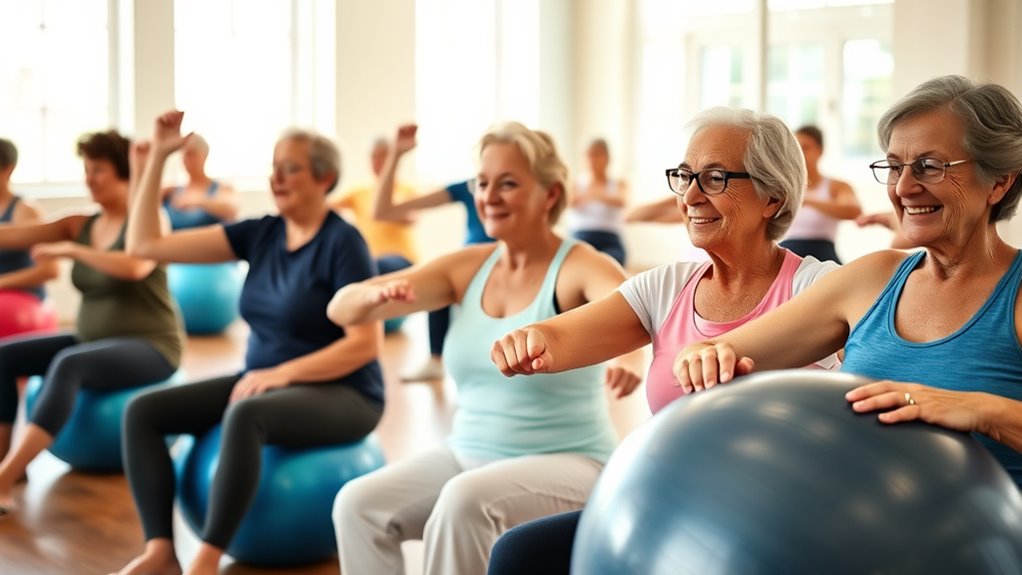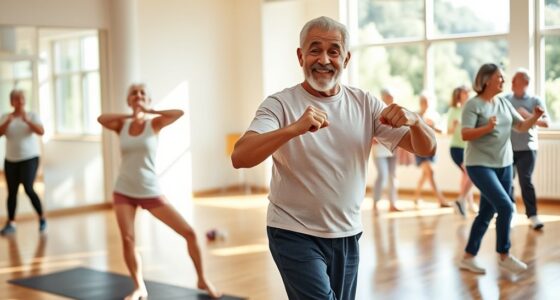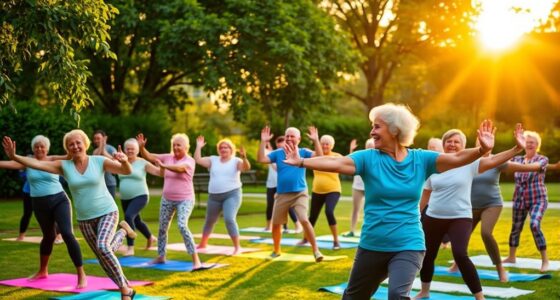Core workouts are essential for seniors, as they enhance stability and reduce the risk of falls. By strengthening the muscles that support your pelvis and spine, you’ll improve your posture and make daily activities easier. Start with simple exercises like modified planks and bridges to build strength safely. Remember, proper form and controlled movements are key. If you want to discover more exercises and tips to strengthen your core effectively, there’s plenty more to explore.
Key Takeaways
- Core strength enhances stability, reducing fall risk and improving mobility for daily activities like walking and climbing stairs.
- Modified exercises, such as knee planks and wall-supported side planks, ensure safe core strengthening for seniors.
- Focus on slow, controlled movements to maintain proper form, minimizing injury risk while building core strength.
- Incorporate isometric exercises and functional movements to enhance balance and stability during workouts.
- Regular core workouts, combined with stretching, promote flexibility and alleviate lower back pain, supporting overall well-being.
Importance of Core Strength for Seniors
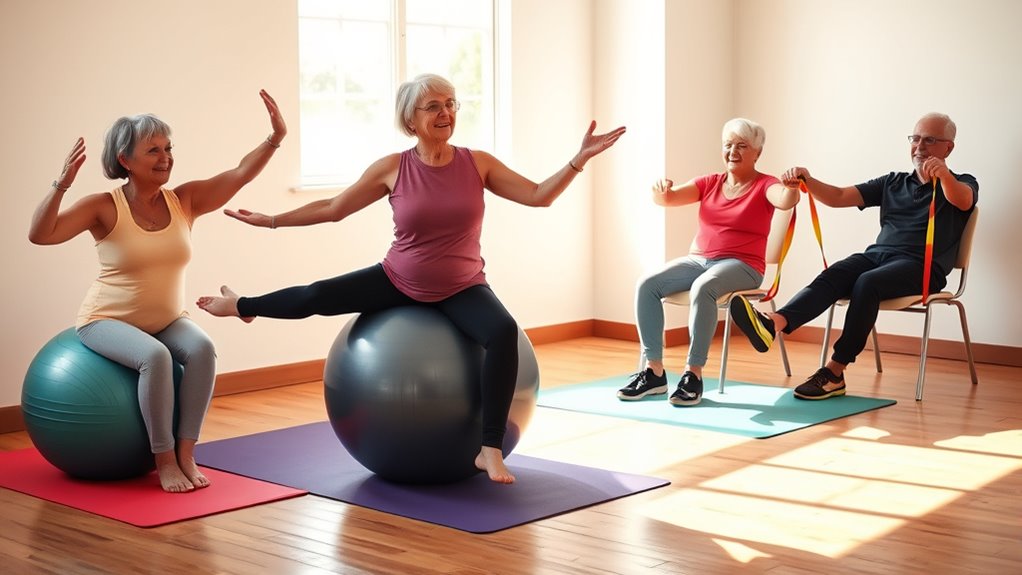
As you age, maintaining core strength becomes essential because it involves 29 muscles that stabilize your pelvis and spine, directly impacting your balance and posture.
For seniors, a strong core enhances stability, making it easier to navigate uneven surfaces and preventing falls—the leading cause of injury. Improved core strength also supports mobility, allowing you to walk, climb stairs, and carry items without strain. Engaging in core exercises not only reduces back pain but promotes better posture, contributing to overall comfort. Regular core strengthening enhances physical performance and boosts your confidence, encouraging an active lifestyle. Additionally, understanding critical periods in physical development can help in tailoring exercises that suit individual capabilities and needs. Incorporating support resources for caregivers can further enhance the overall well-being of seniors as they engage in these exercises. Furthermore, regular exercise can lead to improved health outcomes such as reduced risk of chronic diseases and enhanced quality of life, with studies showing that core strength training positively influences overall physical fitness. A well-developed core also contributes to greater resilience, enabling seniors to better cope with both physical and emotional challenges.
Benefits of Core Exercises for Seniors
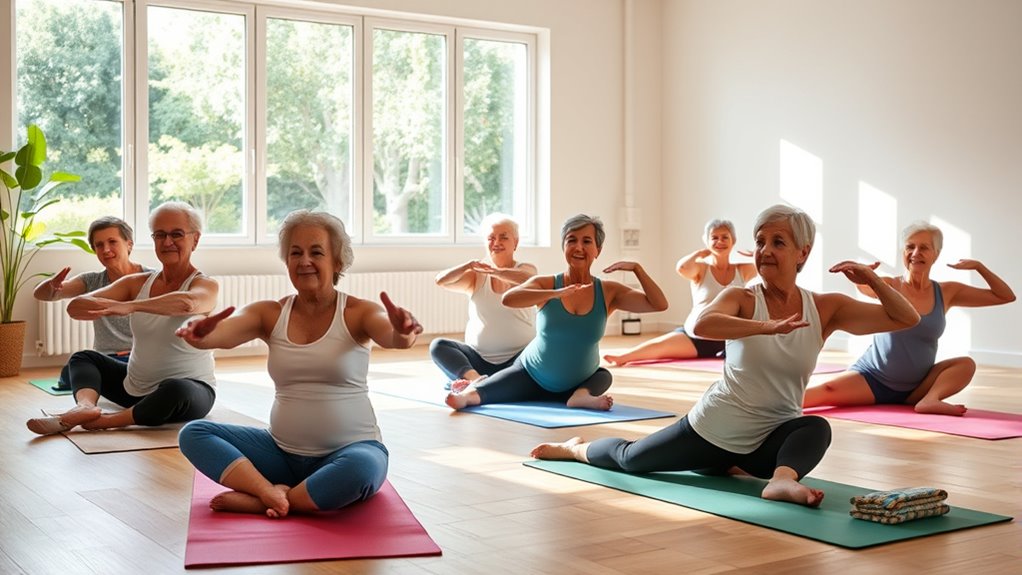
Core exercises offer you improved balance and stability, which are essential for reducing your risk of falls. By strengthening these muscles, you’ll perform daily activities with greater ease and confidence. Embracing core workouts can greatly enhance your overall quality of life. Additionally, incorporating home improvement solutions can further create a safer living environment for seniors. Engaging in these workouts can also be complemented by transforming spaces to better accommodate your needs as you age. Furthermore, practicing core exercises can be beneficial when combined with lightweight and portable options for outdoor activities, which can encourage seniors to remain active and engaged in their fitness routines. Moreover, curiosity contributes to overall life satisfaction, which can motivate seniors to stay active and engaged in their fitness routines. Creating a more organized space can also help reduce stress levels, making it easier to maintain a consistent workout schedule.
Improved Balance and Stability
Improved core strength helps seniors navigate life with confidence by:
- Preventing falls: A strong core provides better body control during movement, reducing the risk of injury.
- Supporting posture: Engaging core muscles stabilizes the pelvis and spine, promoting better alignment. Additionally, proper posture can significantly influence overall health by reducing strain on muscles and joints. This is particularly important as consistent routines can help reinforce good habits over time.
- Enhancing proprioception: Regular core exercises improve your ability to sense body position, contributing to better balance.
- Increasing mobility: Strengthening the core enables you to perform tasks like walking and climbing stairs with greater ease and stability.
Additionally, maintaining high vibrational energy during workouts can significantly enhance overall well-being and support your core strengthening efforts, as it aligns with the principles of vibrational alignment.
Enhanced Daily Activity Performance
Strengthening your core not only boosts your balance and stability but also significantly enhances your ability to perform daily activities. Core exercises for seniors improve mobility, making daily tasks like walking, climbing stairs, and carrying items easier. With stronger core muscles, you’ll experience pain reduction, particularly in your lower back, allowing for a more comfortable lifestyle. Additionally, maintaining a healthy weight can further alleviate stress on your core and enhance your overall well-being. Engaging in regular exercise can also help prevent conditions like gout that affect mobility. Moreover, incorporating low light office plants in your environment can create a calming atmosphere that encourages regular physical activity.
Many seniors find that participating in spiritual retreats can also enhance their overall mental wellbeing, further supporting their physical health goals. This improvement supports better posture, preventing slouching and its associated health issues. As you engage in regular core workouts, you’ll find increased overall activity levels, which fosters independence and encourages participation in recreational activities. Additionally, incorporating yoga practices can further enhance flexibility and strength, complementing your core workout routine.
Reduced Fall Risk
Here are some benefits of core exercises for seniors:
- Improved Mobility: You’ll find it easier to move over uneven surfaces.
- Enhanced Balance: Core strengthening helps you regain stability after a stumble. Additionally, maintaining a strong core can reduce fall risk, as a stable center supports your overall body coordination.
- Increased Independence: Maintaining a strong core supports your ability to perform daily tasks.
- Better Health Outcomes: Stronger core muscles lead to fewer fall-related injuries and improved overall health. Engaging in regular exercise can also help with stress management, contributing to a more balanced emotional state. Furthermore, being physically active can enhance emotional regulation, which is essential for maintaining mental resilience as you age.
Investing in core exercises not only reduces your fall risk but also enhances your quality of life as you age.
Best Core Exercises for Older Adults

When it comes to core exercises for older adults, safety is key, and there are plenty of modifications to suit your needs. Strengthening your core can greatly improve your stability and balance, making everyday activities easier and safer. Let’s explore some effective exercises that can enhance your core strength while keeping you comfortable and secure. Additionally, incorporating unique recipes into your diet can provide essential nutrients that support overall wellness. It’s important to consider establishing a bedtime routine to ensure you’re well-rested for your exercise sessions. Remember that open communication about feelings can also help manage any anxieties you may have about starting a new exercise routine. Engaging in regular physical activity, such as early literacy skills, can further contribute to your overall health and well-being.
Safe Exercise Modifications
While core workouts are essential for maintaining stability and strength, safe exercise modifications are crucial for older adults to avoid injury.
Here are some effective modifications to evaluate:
- Modified Plank: Perform planks on your knees to maintain proper form while building strength.
- Wall Support: Use a wall for support during side planks to enhance stability and balance.
- Isometric Exercises: Engage in isometric exercises, contracting muscles without movement to strengthen your core safely.
- Slow and Controlled Movements: Focus on exercises like bridges, ensuring you move slowly to maximize effectiveness and minimize injury risk.
Benefits of Core Strength
Core strength plays an essential role in promoting stability and balance for older adults. By engaging in core exercises, you can greatly reduce your risk of falls, a leading cause of injury.
These workouts can also alleviate chronic lower back pain by strengthening the muscles that support your spine. Simple exercises, like planks and seated knee lifts, require no special equipment and are suitable for all fitness levels.
Strengthening your core improves your posture and helps you with everyday tasks like walking, bending, and lifting, enhancing your independence. Regular core workouts boost your mobility and combat muscle loss associated with aging, contributing to an overall active lifestyle and better wellbeing.
Getting Started With Core Workouts

Starting a core workout can feel intimidating, but it’s easier than you might think. To get started and effectively strengthen your core, follow these steps:
- Warm-up: Begin by marching in place and moving your arms to boost blood flow.
- Focus on proper form: Use slow, controlled movements to engage multiple muscle groups and guarantee good posture.
- Incorporate functional movements: Choose exercises that enhance balance and stability for daily life activities.
- Maintain flexibility: After your core work, stretch your hip flexors and hamstrings to support overall core health.
Safety Tips and Modifications

When starting on a new core workout routine, it’s important to prioritize safety and make necessary modifications to suit your individual needs.
Always consult a physical therapist or physician, especially if you have pre-existing health conditions. Focus on proper form to minimize injury risk—ensure your movements are controlled and deliberate.
Tailor modifications based on your individual fitness levels, such as performing exercises seated or using support for balance. Gradually progress the intensity, starting with basic movements and slowly incorporating more challenging variations as your strength improves.
Monitor your body’s responses during workouts; take breaks or stop if you experience pain or discomfort. These safety tips will help you enjoy a safe and effective exercise program.
Related Resources and Support

Finding the right resources and support can make a significant difference in your core workout journey. Here are some excellent options for seniors like you:
- Mayo Clinic – Explore their educational materials and podcasts for insights on core strengthening and overall health.
- Hinge Health – Access customized online exercise therapy programs that focus on core strengthening and muscle relief from home.
- Fitness Ball Exercises – Incorporate these safe and effective workouts into your routine to enhance core stability and strength.
- Community Engagement – Participate in initiatives like National Doctors Day to learn about health resources and the importance of physical therapy for chronic low back issues.
Utilizing these resources can support your strength training efforts and contribute to a healthier lifestyle.
Frequently Asked Questions
How to Strengthen Your Core as a Senior?
To strengthen your core as a senior, start by incorporating simple exercises into your daily routine.
Try seated knee lifts and gentle side bends to engage your core muscles without straining. Gradually introduce bridges and planks, adjusting them to your comfort level.
Aim for short sessions, focusing on proper form. Consistency is key, so set aside time each day to enhance your balance and stability, ultimately supporting your overall mobility and independence.
What Is the Single Best Exercise for Core Strength?
The single best exercise for core strength is the plank. You engage multiple muscle groups, including your abs and back, by holding this position.
It promotes stability, improves your posture, and reduces the risk of lower back pain. You can start with modified versions like knee or wall planks if needed.
Regularly practicing planks enhances your balance and functional strength, helping you maintain mobility and independence as you age.
What Are the Big 3 Core Stability Exercises?
So you want to know the “big 3” core stability exercises, huh? Well, brace yourself for this fitness revelation!
First up, there’s the plank—your body’s new best friend, holding you in a push-up position like a statue.
Next, the side plank gives your obliques a workout, balancing on one arm like a graceful flamingo.
Finally, the bird-dog helps you channel your inner animal, extending limbs while keeping your spine neutral.
Core strength, here you come!
How to Strengthen a Very Weak Core?
To strengthen a very weak core, start with simple exercises like seated knee lifts and side bends. These engage your core without too much strain.
Add isometric exercises, like abdominal bracing, to build stability. Gradually incorporate foundational moves such as bridges and modified planks, focusing on controlled movements.
Aim to do these exercises daily for consistent improvement. Always prioritize good form to avoid injury, and consider consulting a healthcare professional for personalized advice.
Conclusion
Strengthening your core isn’t just about aesthetics; it’s about stability, balance, and independence. By incorporating core exercises into your routine, you’ll enhance your mobility, boost your confidence, and improve your overall well-being. So, embrace the journey of core training, enjoy the benefits of a stronger center, and empower yourself to move with grace. Remember, every step you take toward a stronger core is a step toward a healthier, more active life. Keep moving, keep strengthening!
